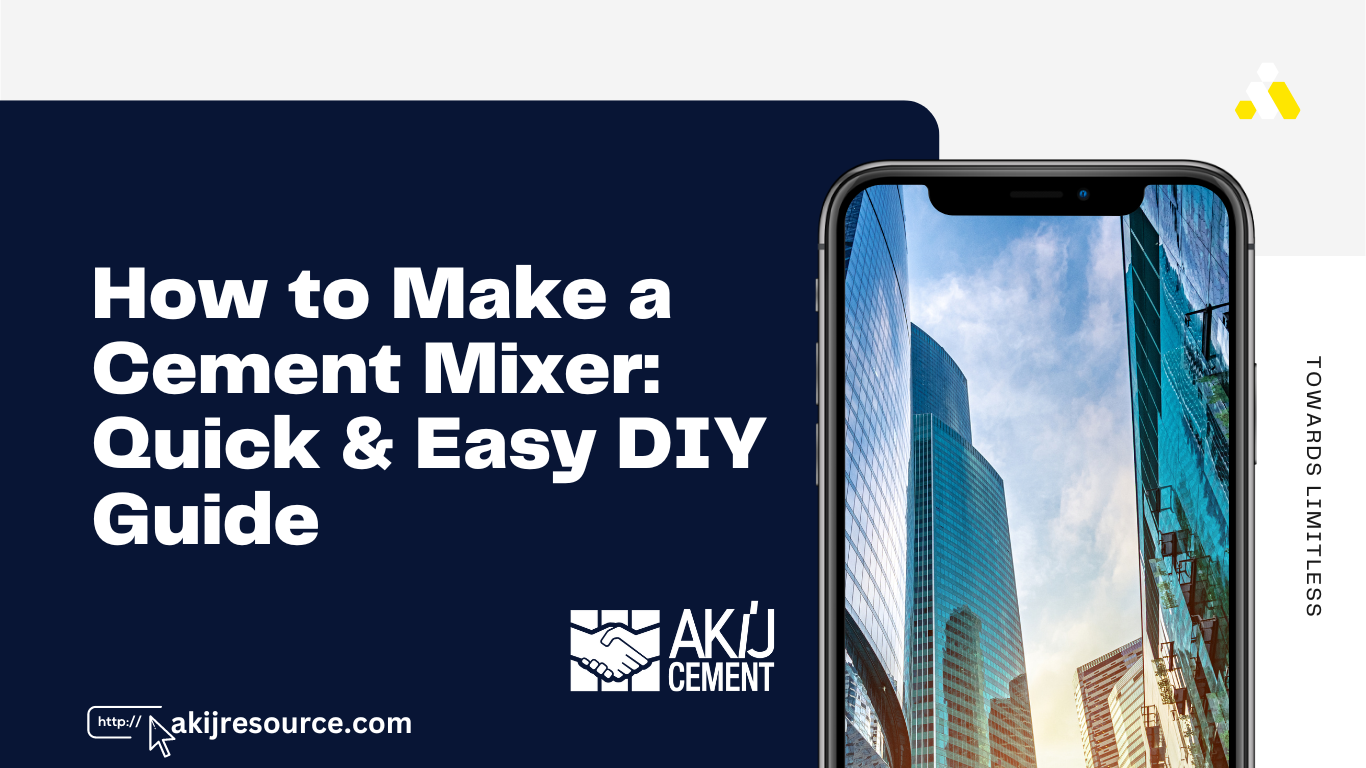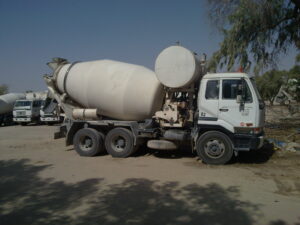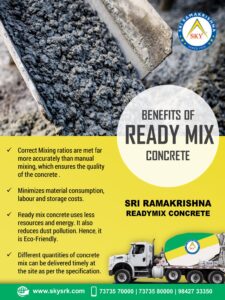To make a cement mixer, gather materials like a drum, motor, and metal frame. Assemble these parts securely.
Building a cement mixer can save money and provide convenience for DIY projects. A homemade mixer allows for better control over mixing and reduces labor costs. Cement mixers are essential for creating concrete for various construction tasks. By constructing your own mixer, you can tailor it to your specific needs.
This DIY project requires basic mechanical skills and some readily available materials. The process involves assembling a motor, drum, and frame into a functional unit. With a little effort and the right tools, you can create a reliable cement mixer to facilitate your construction projects.
Introduction To Diy Cement Mixers
Building your own cement mixer can be a rewarding project. It allows you to understand how these essential construction tools work. You will save money and learn valuable skills.
The Role Of Cement Mixers In Construction
Cement mixers play a crucial role in construction projects. They mix cement, water, and aggregates to form concrete. This mixture is vital for building strong structures.
Without cement mixers, mixing concrete would be a tedious task. Manual mixing is time-consuming and inconsistent. Cement mixers ensure a uniform mix, improving the quality of construction.
Benefits Of Building Your Own Mixer
Creating your own cement mixer has several benefits. First, it is cost-effective. Buying a pre-made mixer can be expensive. Building your own can save you a significant amount of money.
Second, it allows for customization. You can build a mixer that suits your specific needs. This flexibility is not available in store-bought mixers.
Third, it is a fun and educational project. You will learn about mechanics and construction. This knowledge can be applied to other DIY projects.
| Benefit | Explanation |
|---|---|
| Cost-Effective | Save money by building instead of buying a mixer. |
| Customization | Create a mixer tailored to your needs. |
| Educational | Learn about mechanics and construction through the building process. |
Here are some key steps to keep in mind when building your own mixer:
- Gather all necessary materials.
- Follow a detailed plan or blueprint.
- Ensure all parts fit together securely.
- Test the mixer before using it for a project.
By following these steps, you can build a reliable and efficient cement mixer. Enjoy the process and the results of your hard work.

Credit: makezine.com
Essential Components Of A Cement Mixer
Building a cement mixer is easy. You need to know the important parts. These parts help the mixer work well. Let’s look at the key components.
Drum: The Mixing Vessel
The drum is the heart of the cement mixer. It holds all the ingredients. The drum spins to mix cement, sand, and water. It must be strong and durable. Most drums are made of metal. They can handle heavy loads and tough mixing.
Motor: Powering The Mix
The motor is what makes the drum spin. It provides the power needed for mixing. Motors come in different sizes and strengths. A good motor is reliable and energy-efficient. It ensures the mix is smooth and even.
Frame: The Supporting Structure
The frame holds everything together. It supports the drum and motor. The frame must be sturdy and stable. It should be made of strong materials. A well-built frame keeps the mixer safe and steady during use.
Tools And Materials Needed
Constructing a cement mixer requires specific tools and materials. Selecting the right ones ensures a smooth and successful build. Below, we break down the essential tools and materials you need to create a cement mixer.
List Of Tools
- Electric Drill: Essential for drilling holes and mixing.
- Wrench Set: Useful for tightening bolts and nuts.
- Screwdriver Set: Needed for assembling parts.
- Measuring Tape: Ensures accurate measurements.
- Hammer: Helps in assembling the frame.
- Safety Gear: Includes gloves and goggles for protection.
Choosing The Right Materials
| Material | Description |
|---|---|
| Steel Drum | A sturdy drum for mixing cement. |
| Steel Frame | Provides a strong base for the mixer. |
| Motor | Powers the mixer for efficient mixing. |
| Bolts and Nuts | Secures parts together firmly. |
| Mixing Blades | Ensures the cement is mixed evenly. |
Ensure you gather all the listed tools and materials before starting the construction. This preparation helps in building the cement mixer efficiently and safely.

Credit: www.wikihow.com
Safety Considerations Before You Begin
Before you start making a cement mixer, it’s crucial to prioritize safety. Handling heavy tools and materials can be risky. Proper safety measures can prevent accidents and injuries. Let’s explore the key safety considerations you need to address.
Personal Protective Equipment
Wearing the right Personal Protective Equipment (PPE) is essential. Make sure you have the following:
- Safety goggles to protect your eyes from dust and debris.
- Gloves to safeguard your hands from sharp tools and rough materials.
- Ear protection if you’re using loud machinery.
- Steel-toed boots to protect your feet from heavy objects.
- Dust mask to prevent inhalation of harmful particles.
Safe Handling Of Tools And Materials
Proper handling of tools and materials is crucial for safety. Follow these guidelines:
- Read the manual for each tool you use. Understand its functions and safety features.
- Inspect tools before use. Ensure they are in good condition and free of defects.
- Keep your workspace clean. Remove any clutter that could cause tripping or accidents.
- Store materials properly. Keep heavy items close to the ground and secure to prevent falls.
- Use tools correctly. Avoid shortcuts that could lead to injuries.
By following these safety considerations, you can ensure a safer environment while making your cement mixer. Prioritize your well-being and stay safe!
Step-by-step Assembly Instructions
Building your own cement mixer can save money and provide a valuable tool. Follow these step-by-step assembly instructions to create your mixer.
Building The Frame
The frame is the base of your cement mixer. You need sturdy materials for a strong frame.
- Use steel bars or angle iron.
- Cut the steel bars to the required lengths.
- Weld or bolt the bars together to form a rectangular frame.
- Add additional bars for support and stability.
Attaching The Motor
The motor powers the cement mixer. It must be securely attached to the frame.
- Choose a motor with adequate power.
- Mount the motor on a steel plate.
- Secure the plate to the frame using bolts.
- Ensure the motor is aligned properly.
Assembling The Drum
The drum mixes the cement. It should be strong and well-balanced.
- Use a steel drum or a strong plastic barrel.
- Drill holes for the mixing blades inside the drum.
- Attach the mixing blades securely.
- Mount the drum on a rotating shaft.
Connecting The Components
Connecting all parts ensures the cement mixer works efficiently.
| Component | Connection Method |
|---|---|
| Drum | Connect to the rotating shaft. |
| Motor | Attach to the frame. |
| Frame | Ensure all parts are securely fastened. |
Once connected, test the mixer to ensure it works properly. Adjust as needed for smooth operation.
Testing Your Cement Mixer
Before you use your homemade cement mixer, it’s crucial to test it. Testing ensures that your mixer works efficiently and safely. Follow these steps to make sure your cement mixer is in top shape.
Performing A Dry Run
A dry run is essential to check the basic functionality of your mixer. Start by turning on the mixer without any materials.
Listen for any unusual sounds. Make sure the drum rotates smoothly and evenly.
Check the stability of the entire setup. The mixer should not shake or wobble.
- Check Power: Ensure the power source is stable and consistent.
- Inspect Drum Rotation: Verify the drum rotates without hesitation.
- Look for Leaks: Ensure there are no leaks in the drum or around the motor.
Troubleshooting Common Issues
Addressing issues early can save you time and effort. Here are common problems and their solutions:
| Issue | Possible Cause | Solution |
|---|---|---|
| Drum not rotating | Loose belt or low power | Tighten the belt or check power source |
| Unusual noise | Loose parts or debris | Secure parts and clean out debris |
| Leaking drum | Crack or poor assembly | Seal cracks and inspect assembly |
If the drum does not rotate, the belt might be loose. Tighten it and ensure it has the correct tension.
Unusual noises could indicate loose parts or debris inside the mixer. Secure all parts and clean out the debris.
For a leaking drum, check for cracks or poor assembly. Seal any cracks and inspect the assembly for any flaws.
Maintenance Tips For Longevity
Maintaining a cement mixer ensures it lasts longer and performs efficiently. Regular maintenance prevents breakdowns and costly repairs. Here are some essential tips for keeping your cement mixer in top shape.
Regular Cleaning
Cleaning the cement mixer after each use is crucial. Remove any leftover cement from the drum, paddles, and other parts. Use a hose to wash off the residue. A brush can help scrub off stubborn cement.
Don’t forget to clean the exterior of the mixer. Wipe down the frame and wheels to remove dirt and grime. This prevents rust and keeps the mixer looking new.
Motor Care
The motor is the heart of your cement mixer. Ensure it’s in good working condition. Check the motor’s ventilation. Clean out any dust or debris that could cause overheating.
Lubricate the motor bearings regularly. Use the recommended oil for lubrication. This keeps the motor running smoothly and extends its life.
If you notice any strange noises or performance issues, inspect the motor immediately. Early detection of problems can prevent major damage.
Checking For Wear And Tear
Inspect the mixer parts regularly for signs of wear and tear. Look for cracks, rust, or loose bolts. Tighten any loose parts to ensure safety and efficiency.
Replace worn-out parts promptly. This includes belts, paddles, and any other components that show significant wear. Using worn parts can lead to breakdowns and unsafe operation.
Keep a maintenance log. Record each inspection and any repairs made. This helps track the condition of your mixer and schedule future maintenance.
| Maintenance Task | Frequency | Tools Needed |
|---|---|---|
| Cleaning the drum | After every use | Hose, brush |
| Motor lubrication | Monthly | Oil |
| Inspection for wear and tear | Weekly | Wrench, flashlight |

Credit: m.youtube.com
Innovative Uses For Your Diy Cement Mixer
Creating a DIY cement mixer opens up a world of possibilities. Your handmade mixer can do more than just mix cement. It can serve many other purposes, making your investment even more valuable. Explore these innovative uses for your DIY cement mixer.
Beyond Cement: Other Mixing Uses
Your cement mixer can mix more than just cement. It can help with a variety of other materials.
- Soil Mixing: Combine different types of soil for gardening.
- Composting: Mix compost materials evenly for faster decomposition.
- Animal Feed: Blend grains and other feed ingredients.
- Paint: Ensure consistent color by mixing paint batches.
Using your cement mixer for these tasks saves time and ensures even mixing. It also keeps your hands clean and reduces effort.
Community Projects And Collaboration
Your DIY cement mixer can benefit the community. Use it for collaborative projects.
| Project Type | Benefits |
|---|---|
| Community Gardens | Prepare soil quickly and efficiently. |
| Local Construction | Assist with small-scale building projects. |
| Art Installations | Mix materials for community art pieces. |
| Clean-up Drives | Make compost or mix cleaning agents. |
Involve neighbors and friends in these projects. It fosters a sense of community and teamwork.
Utilize your cement mixer for more than just construction tasks. Its versatility makes it a valuable tool for various projects.
Conclusion: The Rewards Of Diy Construction Tools
Crafting your own cement mixer can save money and enhance your DIY skills. Building this essential tool empowers you to tackle construction projects with confidence.
Building your own cement mixer brings many rewards. You save money and gain personal satisfaction. These benefits make the effort worthwhile.
Cost Savings And Personal Achievement
Creating your own cement mixer can cut expenses. Store-bought mixers can be costly. By building one yourself, you spend less.
| Expense Type | DIY Cost | Store-Bought Cost |
|---|---|---|
| Materials | $100 | $400 |
| Labor | Free (Your Time) | $50 |
| Total | $100 | $450 |
Personal achievement is another perk. Building something with your hands feels amazing. You develop skills and gain confidence.
- You learn new skills.
- You feel proud of your work.
- You gain confidence.
Next Steps In Diy Construction
Finished your cement mixer? Consider your next project. Many DIY construction tools await you.
- Build a brick press.
- Create a concrete mold.
- Design a custom workbench.
Each new project builds your skills. You become a more capable DIY builder. The journey of learning never ends.
Share your success with friends and family. They may join you in future projects.
Keep pushing your limits. Every project makes you better.
“`
Frequently Asked Questions
What Mix For A Cement Mixer?
Use a mix of 1 part cement, 2 parts sand, and 3 parts gravel. Add water until smooth.
Is It Better To Mix Concrete By Hand Or Mixer?
Using a concrete mixer is better. It ensures consistency, saves time, and reduces physical strain compared to hand mixing.
How To Make A Cement Mixer On A Drill?
Attach a mixing paddle to the drill. Secure it tightly. Use a bucket to hold the cement mixture. Mix thoroughly until smooth.
How To Make A Cement Mixture?
Mix cement, sand, and gravel in a 1:2:3 ratio. Add water gradually. Stir until smooth.
Conclusion
Building your own cement mixer can be rewarding and cost-effective. Follow the steps carefully for a durable mixer. This project not only saves money but also provides valuable hands-on experience. Enjoy the process and take pride in your self-built cement mixer.
Happy mixing and building!






